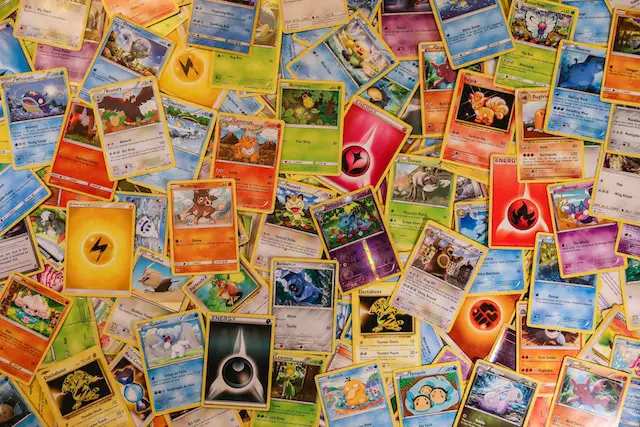Pokemon cards have become more than just a beloved trading card game; they have evolved into highly sought-after collector’s items. From rare editions to limited releases, certain Pokemon cards have skyrocketed in value, fetching astonishing prices in the market.
In this article, we dive into the world of Pokemon card collecting and explore the realm of luxury, presenting to you the ten most expensive Pokemon cards in the world. These cards, with their rarity, condition, and desirability among collectors, have reached astronomical price tags, making them coveted treasures for both avid Pokemon enthusiasts and astute investors alike.
10 Most Expensive Pokemon Cards In The World
| No | Most Expensive Pokemon Card | Price |
| 1 | Pikachu Illustrator | $5.275 million |
| 2 | 1999 Pokemon Base Set Shadowless 1st Edition Holo Charizard | $420,000 |
| 3 | 1998 Pokemon Commission Presentation Galaxy Star Holo Blastoise | $360,000 |
| 4 | Black Star Ishihara Signed GX Promo Card | $247,230 |
| 5 | Kangaskhan-Holo #115 Family Event Trophy Card |
$150,100
|
| 6 | 2000 Pokemon Neo Genesis 1st Edition Holo Lugia |
$144,300
|
| 7 | 1998 Trophy Pikachu Gold | $128,900 |
| 8 | 2006 Pokémon World Championships Promo No. 2 Trainer | $110,100 |
| 9 | 1999 Super Secret Battle No. 1 Trainer | $90,000 |
| 10 | 1998 Pokemon Japanese Promo Tamamushi University Prize Magikarp | $78,000 |
Pikachu Illustrator
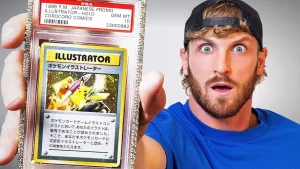
Pikachu Illustrator is the most expensive pokemon card in the world. Pikachu Illustrator is the holy grail of Pokemon cards, revered as the rarest and most valuable card in existence. Released in 1998 as a prize for the CoroCoro Comic Illustration Contest, only a handful of Pikachu Illustrator cards were ever produced, making it an exceedingly rare find.
This card features a unique design, showcasing an illustration of Pikachu with an artist’s brush. Its exclusivity and iconic status have propelled its value to astronomical heights, with some reported sales reaching millions of dollars.
As the pinnacle of Pokemon card collecting, Pikachu Illustrator continues to captivate enthusiasts and collectors worldwide, representing the pinnacle of rarity and prestige in the Pokemon card universe.
1999 Pokemon Base Set Shadowless 1st Edition Holo Charizard
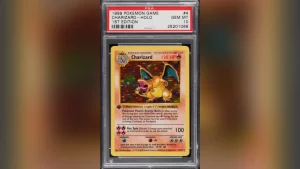
1999 Pokemon Base Set Shadowless 1st Edition Holo Charizard is the 2nd most expensive pokemon card in the world. The 1999 Pokemon Base Set Shadowless 1st Edition Holo Charizard holds a legendary status in the world of Pokemon card collecting. As one of the most iconic and sought-after cards, it features the majestic Charizard in holographic glory.
What sets this card apart is its “Shadowless” attribute, lacking the shadow underneath the image box, making it a rarer variant. As a first-edition print, it holds immense nostalgic value and represents the foundation of the Pokemon TCG phenomenon.
The combination of its scarcity, iconic character, and holofoil allure has catapulted its value to astonishing heights, making it a prized possession for collectors and a symbol of the enduring popularity of Pokemon.
1998 Pokemon Commission Presentation Galaxy Star Holo Blastoise
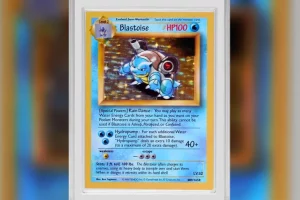
1998 Pokemon Commission Presentation Galaxy Star Holo Blastoise is the 3rd most expensive pokemon card in the world. The 1998 Pokemon Commission Presentation Galaxy Star Holo Blastoise stands as a true gem among Pokemon card collectors. This exceptionally rare and unique card was never released to the public, making it an extraordinary find.
Commissioned by Wizards of the Coast as a prototype for a potential promotional card, the Galaxy Star Holo Blastoise features a stunning galactic design that captivates the imagination.
With its holographic artwork and pristine condition, this card holds immense allure and mystique. Its limited production and exclusive nature have skyrocketed its value, making it one of the most coveted and elusive treasures for Pokemon enthusiasts and collectors alike.
Black Star Ishihara Signed GX Promo Card
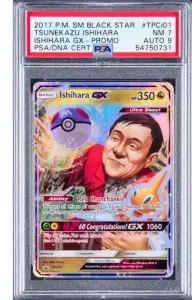
Black Star Ishihara Signed GX Promo Card is the 4th most expensive pokemon card in the world. The Black Star Ishihara Signed GX Promo Card is a true collector’s delight, cherished for its rarity and unique personal touch. This special edition Pokemon card features the signature of Tsunekazu Ishihara, the president, and CEO of The Pokemon Company.
Limited in availability and exclusively distributed during select events and promotions, this card holds immense value for avid collectors. Its sleek design, combined with its prestigious signature, adds an extra layer of authenticity and desirability.
As a highly sought-after item in the Pokemon TCG community, the Black Star Ishihara Signed GX Promo Card embodies both the allure of a rare collectible and the personal connection to the visionary behind the Pokemon franchise.
Kangaskhan-Holo #115 Family Event Trophy Card
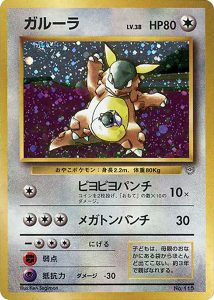
Kangaskhan-Holo #115 Family Event Trophy Card is the 5th most expensive Pokemon card in the world. The Kangaskhan-Holo #115 Family Event Trophy Card stands as a prized gem among Pokemon collectors, coveted for its exclusivity and unique significance. This extraordinary card was specifically created to commemorate the Family Event Tournament held in 1999, making it an extremely rare find.
Featuring a holographic Kangaskhan, this card captures attention with its striking design and pristine condition. Limited in distribution and accessible only to tournament participants and their families, this trophy card represents both a cherished memento and a symbol of achievement.
With its scarcity, captivating artwork, and historical importance, the Kangaskhan-Holo #115 Family Event Trophy Card holds an esteemed place in the world of Pokemon card collecting.
2000 Pokemon Neo Genesis 1st Edition Holo Lugia
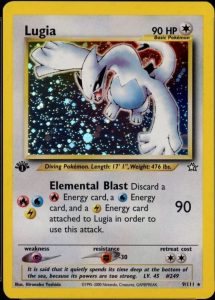
2000 Pokemon Neo Genesis 1st Edition Holo Lugia is the 6th most expensive Pokemon card in the world. The 2000 Pokemon Neo Genesis 1st Edition Holo Lugia stands as a true treasure among collectors, revered for its beauty and scarcity. This holofoil card features the majestic Lugia, one of the most iconic Legendary Pokemon, in all its glory.
Being a first edition from the Neo Genesis set adds to its desirability, while the holographic effect enhances its visual appeal. With limited quantities printed during its initial release, the 1st Edition Holo Lugia has become a highly sought-after card, commanding significant value in the market. Its combination of legendary status, first edition rarity, and stunning artwork make it a prized addition to any Pokemon card collection.
1998 Trophy Pikachu Gold
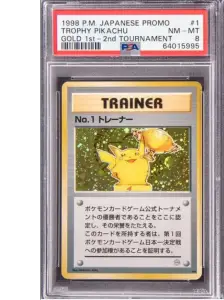
1998 Trophy Pikachu Gold is the 7th most expensive Pokemon card in the world. The 1998 Trophy Pikachu Gold card is an exceedingly rare and highly coveted gem within the realm of Pokemon card collecting. This special edition card was exclusively awarded as a prize in the 1998 Pokemon World Championships held in Japan, making it an extremely limited and elusive find.
Adorned with a stunning gold finish, this Pikachu card represents a symbol of achievement and mastery within the competitive Pokemon community.
With its unique design, scarce availability, and immense prestige, the 1998 Trophy Pikachu Gold card holds an esteemed place among collectors, encapsulating the spirit of victory and the extraordinary allure of rare Pokemon memorabilia.
2006 Pokémon World Championships Promo No. 2 Trainer
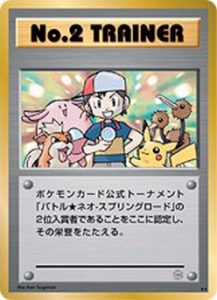
2006 Pokémon World Championships Promo No. 2 Trainer is the 8th most expensive Pokemon card in the world. The 2006 Pokémon World Championships Promo No. 2 Trainer card holds a special place in the hearts of Pokemon enthusiasts and collectors. This highly sought-after promotional card was exclusively distributed to participants of the 2006 Pokémon World Championships, adding to its rarity and desirability.
Featuring a captivating artwork showcasing a Trainer and their Pokémon team, this card represents the spirit of competition and camaraderie in the Pokemon community. Its limited availability and association with the prestigious World Championships make it a coveted addition to any collection.
With its unique significance and limited distribution, the 2006 Pokémon World Championships Promo No. 2 Trainer card stands as a cherished memento from an esteemed event in Pokemon history.
1999 Super Secret Battle No. 1 Trainer
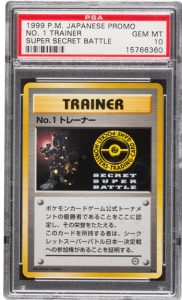
1999 Super Secret Battle No. 1 Trainer is the 9th most expensive Pokemon card in the world. The 1999 Super Secret Battle No. 1 Trainer card holds a legendary status among Pokemon collectors, renowned for its extreme rarity and enigmatic allure.
This card was exclusively distributed to winners of the Super Secret Battle, a secret tournament held in Japan in 1999. As the very first promotional Trainer card ever released, it holds immense historical significance and sentimental value.
With its mysterious origins and limited production, the Super Secret Battle No. 1 Trainer card has become a holy grail for collectors, commanding astronomical prices in the market. Owning this card is like possessing a hidden piece of Pokemon history, making it a true gem in the world of Pokemon card collecting.
1998 Pokemon Japanese Promo Tamamushi University Prize Magikarp
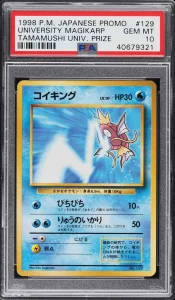
1998 Pokemon Japanese Promo Tamamushi University Prize Magikarp is the 10th most expensive Pokemon card in the world. The 1998 Pokemon Japanese Promo Tamamushi University Prize Magikarp card is a rare and highly sought-after gem in the world of Pokemon card collecting. This unique promotional card was awarded as a prize in the Tamamushi University Pokemon Card Game Illustration Contest held in Japan.
Featuring an exclusive artwork of Magikarp, this card represents the artistic talent and creativity of the contest participants. With limited quantities produced and its association with a prestigious event, the Tamamushi University Prize Magikarp card holds immense value and prestige among collectors. Its rarity, distinctive design, and connection to the Pokemon art community make it a prized possession for enthusiasts seeking rare and remarkable additions to their collections.
Frequently Asked Questions
What is the rarest Pokemon card?
The rarest Pokemon card is the Pokemon Illustrator card, also known as Pikachu Illustrator. Produced in 1998, it is an exceedingly limited edition card with only a reported 39 copies ever printed.
This highly sought-after card was never made available for public sale and was exclusively awarded as a prize to winners of the CoroCoro Comic Illustration Contest in Japan. With its unique artwork, featuring a Pikachu holding a paintbrush, and its scarcity, the Pokemon Illustrator card is considered the pinnacle of a rarity among collectors.
Owning this card represents the ultimate achievement in Pokemon card collecting, making it the most elusive and coveted gem in the Pokemon TCG universe.
How to tell if a Pokemon card is fake?
Determining the authenticity of a Pokemon card can be crucial in avoiding counterfeit or fake cards. To spot fakes, scrutinize the card’s printing quality, including color accuracy, texture, and alignment. Examine the card’s holographic features, ensuring they display the correct patterns and shine.
Pay attention to the font and text on the card, looking for inconsistencies or errors. Authentic cards will have a proper copyright symbol and accurate set symbols. Compare the card’s weight and thickness to genuine ones.
Additionally, cross-reference the card’s details with official sources or consult experts and online communities for validation. By being vigilant and thorough in examining these key elements, one can increase their chances of identifying counterfeit Pokemon cards.
What is the best Pokemon card?
One card that often stands out among collectors and players is the Shadowless First Edition Charizard card from the 1999 Pokemon Base Set. This iconic card features the powerful Charizard in holographic form and holds a special place in the hearts of many fans. With its scarcity, stunning design, and historical significance as a symbol of the Pokemon TCG’s early days, the Shadowless First Edition Charizard card is often revered as one of the most coveted and sought-after cards in the Pokemon card collecting community.
How much is a Pokemon card worth?
The value of a Pokemon card can vary greatly depending on several factors, including its rarity, condition, popularity, and demand among collectors.
While some cards may be relatively affordable, others can command astronomical prices, particularly if they are highly sought-after or considered rare gems.
First-edition cards, holographic versions, or those featuring iconic Pokemon tend to hold greater value. Additionally, the overall condition of the card, such as centering, corners, and surface quality, can impact its worth.
To accurately determine a Pokemon card’s value, it is recommended to consult pricing guides, and professional grading services, or engage with knowledgeable collectors and enthusiasts who can provide insights into the card’s market value.
How to get a Pokemon card graded?
Getting a Pokemon card graded involves a straightforward process.
First, choose a reputable card grading service such as PSA, Beckett, or CGC. Create an account on their website and select the grading tier that suits your needs.
Prepare your card by ensuring it is clean, free from debris, and properly protected in a card sleeve or holder. Fill out the submission form, including details about the card and desired services. Package the card securely and ship it to the grading service, following their guidelines.
Once received, the grading company will assess the card’s condition, assign a grade based on factors like centering, corners, and surface quality, and encapsulate it in a protective case.
The graded card will then be returned to you, providing an official assessment of its condition and enhancing its value within the collecting community.
How to play the Pokemon card game?
Playing the Pokemon card game involves a few key steps. Each player assembles a deck of 60 cards, including Pokemon, Energy cards, and Trainer cards. The objective is to defeat the opponent’s Pokemon by reducing their HP to zero.
Players take turns, starting by drawing a card and potentially playing Basic Pokemon. By attaching Energy cards, using Trainer cards, and evolving Pokemon, players can launch attacks and employ various strategies. Key elements include managing resources, building a balanced deck, and strategically timing actions.
Victory can be achieved through knockout or by collecting all the prize cards. The game combines strategy, deck-building, and a touch of luck, making it an engaging and dynamic experience for players of all ages.
How to tell if a Pokemon card is rare?
Determining if a Pokemon card is rare involves examining certain characteristics. Rarity can be indicated by symbols on the card, such as a circle, diamond, or star, often found in the bottom right corner. These symbols represent common, uncommon, and rare cards, respectively.
Holographic or foil cards, where certain parts of the artwork shine or reflect light, are often rare. Additionally, cards from limited edition sets or those with unique features, like special artwork or promotional stamps, tend to be rare. Researching the card’s release year, set, and collector’s guides can provide further insights into its rarity.
By assessing these factors, collectors can better understand the rarity and potential value of a Pokemon card.
What is the most valuable Pokemon card?
The most valuable Pokemon card is the Pikachu Illustrator card, also known as Pikachu Illustrator. Produced in 1998 as a promotional card for the CoroCoro Comic Illustration Contest, it is an exceedingly rare and highly coveted collector’s item.
With only a reported 39 copies ever printed and its unique artwork featuring Pikachu holding a paintbrush, this card holds an unparalleled status among collectors.
Owning the Pikachu Illustrator card represents the pinnacle of Pokemon card collecting, making it the most valuable and sought-after gem in the entire Pokemon TCG universe, often commanding astronomical prices at auctions and being the crown jewel of any serious collector’s portfolio.
How much does it cost to grade a Pokemon card?
The cost to grade a Pokemon card varies depending on several factors. Professional grading services like PSA, Beckett, or CGC offer different pricing tiers based on the card’s declared value, desired turnaround time, and additional services.
Generally, grading fees start around $10 for lower-value cards and can range up to several hundred dollars for high-value or rare cards. Additional services like expedited processing, autograph authentication, or special encapsulation may incur extra charges.
What is a shadowless Pokemon card?
A shadowless Pokemon card refers to a specific variation of the early Pokemon TCG cards that lack a shadow beneath the illustration box.
Released during the initial print runs of the Base Set, these shadowless cards are highly sought after by collectors. The absence of the shadow was a result of a production error during the printing process, making them relatively rare compared to their shadowed counterparts.
The shadowless cards hold a nostalgic charm and are considered valuable due to their unique appearance and historical significance as the early iterations of the Pokemon TCG, making them prized additions to any collection of Pokemon cards.
How to tell if a Pokemon card is the first edition?
Identifying whether a Pokemon card is a first edition involves examining specific characteristics. Look for the “Edition 1” symbol, typically found near the card’s set symbol, indicating its first edition status.
Additionally, check for the absence of a rarity symbol below the card’s image, as first-edition cards often lack this symbol. The text “First Edition” may also be present on the card, explicitly denoting its status.
Keep in mind that first edition cards were predominantly released in early print runs, so they may exhibit different print quality, such as glossier card stock or different font sizes.
Consulting official card guides, or collector resources, or seeking expert advice can help confirm a Pokemon card’s first edition status.
What was the first Pokemon card?
The first-ever Pokemon card released was “Pikachu” from the Base Set of the Pokemon Trading Card Game (TCG).
Introduced in 1996 in Japan and later in 1999 internationally, this iconic card holds historical significance as the starting point of the Pokemon TCG phenomenon.
The Pikachu card features the beloved electric mouse Pokemon in a charming artwork by Ken Sugimori. As the face of the franchise, Pikachu’s inclusion in the inaugural set solidified its status as the mascot and symbol of Pokemon.
The release of this foundational card marked the beginning of an enduring collectible card game that has captivated millions of fans worldwide.

